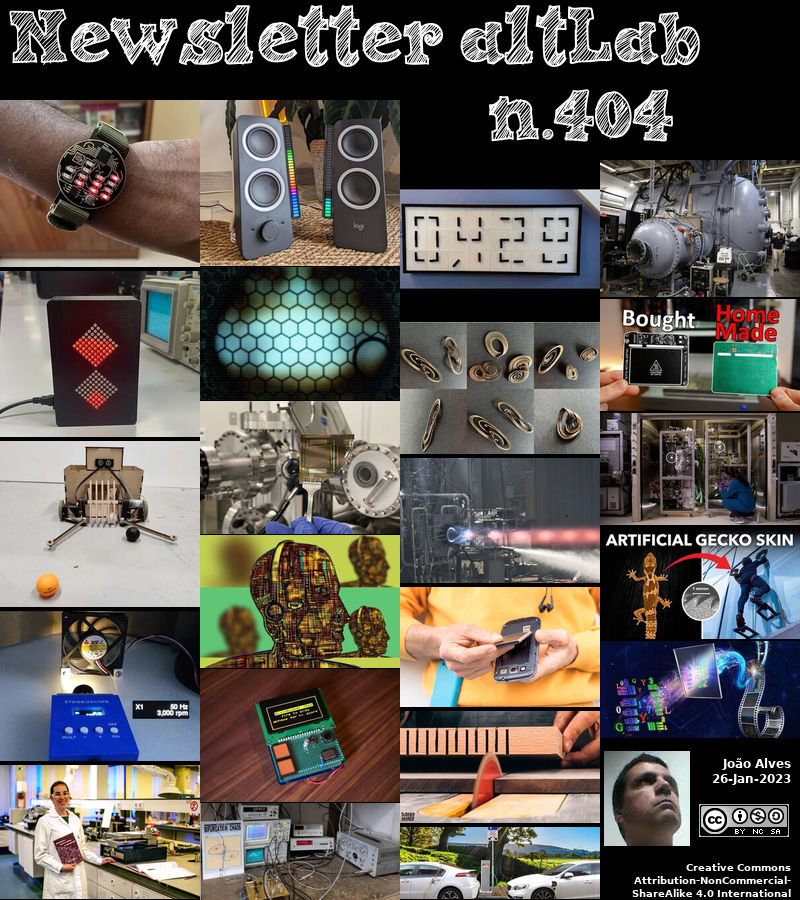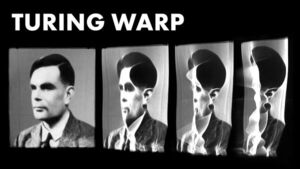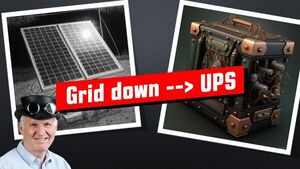2023-01-26 - Nº 404
Editorial
Esta é a Newsletter Nº 404 que se apresenta com o mesmo formato que as anteriores. Se gostar da Newsletter partilhe-a!
Todas as Newsletters encontram-se indexadas no link.
Esta Newsletter tem os seguintes tópicos:
Faz hoje anos que nascia, em 1832, o cirurgião e inventor norte-americano Rufus Henry Gilbert. Ele desempenhou um papel importante no desenvolvimento do trânsito rápido na cidade de Nova Iorque. Depois de servir como cirurgião no Exército Federal na Guerra Civil, interessou-se pelo trânsito rápido como meio de libertar as pessoas de viverem nos cortiços insalubres e apinhados nos centros das grandes cidades. Gilbert obteve duas patentes em 1870 sobre um sistema de tubos pneumáticos, e incorporou a Gilbert Electric Railway Company a 17 de Junho de 1872, para construir linhas elevadas na cidade de Nova Iorque. Os carros seriam propulsionados por pressão de ar de tubos pneumáticos montados na estrutura elevada. Uma depressão financeira atrasou a construção até 1876, e obrigou à adopção de uma via convencional com comboios puxados por locomotivas a vapor, que abriu a 6 de Junho de 1878.
Faz também hoje anos que nascia, em 1909, o químico escocês Alexander King. Ele foi pioneiro na sensibilização ambiental, alertando para os perigos que o desenvolvimento industrial extensivo representa para o ambiente. Ele co-comissionou o relatório Limites ao Crescimento de 1972, que iniciou a atenção internacional às preocupações ambientais. Continua a ser um dos livros mais vendidos do mundo sobre o ambiente. Depois de dirigir a investigação científica como parte do esforço de guerra na II Guerra Mundial, voltou-se para a aplicação da ciência para a melhoria da vida. Em particular, foi cientista chefe no departamento de investigação científica e industrial (1950-56), trabalhando para ajudar as fábricas britânicas a tornarem-se mais produtivas. Após a publicação de Limites ao Crescimento, co-fundou o Clube de Roma, um grupo de reflexão centrado na forma de estabelecer um desenvolvimento sustentável. Foi o presidente desse grupo em 1984-90.
Por fim, faz hoje anos que nascia, em 1911, o físico germano-americano Polykarp Kusch. Ele partilhou o Prémio Nobel da Física em 1955 pela sua determinação precisa de que o momento magnético do electrão é maior do que o seu valor teórico. Isto ele deduziu ao pesquisar a estrutura hiperfina dos níveis energéticos em certos elementos, e em 1947 encontrou uma discrepância de cerca de 0,1% entre o valor observado e o previsto pela teoria. Embora minuciosa, esta anomalia foi de grande significado e levou a teorias revistas sobre as interacções dos electrões com a radiação electromagnética, agora conhecida como electrodinâmica quântica. (Partilhou o prémio com Willis E. Lamb, Jr., que realizou experiências independentes mas relacionadas na Universidade de Columbia sobre a estrutura hiperfina do átomo de hidrogénio).
O Asteróide 2023 BU tem aproximadamente o tamanho de um camião e prevê-se que faça uma das aproximações mais próximas por um objecto próximo da Terra alguma vez registado. Nesta quinta-feira, 26 de Janeiro, um pequeno asteróide próximo da Terra terá um encontro muito próximo com o nosso planeta. Designado 2023 BU, o asteróide vai fazer zoom sobre a ponta sul da América do Sul por volta das 16:27 PST (19:27 p.m. EST) apenas 3.600 quilómetros acima da superfície do planeta e bem dentro da órbita dos satélites geossíncronos.
Na Newsletter desta semana apresentamos diversas noticias, artigos científicos, projetos de maker e alguns vídeos interessantes. É apresentado a MagPI nº126 de Fevereiro.
 João Alves ([email protected])
João Alves ([email protected])
O conteúdo da Newsletter encontra-se sob a licença  Creative Commons Attribution-NonCommercial-ShareAlike 4.0 International License.
Creative Commons Attribution-NonCommercial-ShareAlike 4.0 International License.
Novidades da Semana

NASA System Predicts Small Asteroid to Pass Close by Earth This Week
"Asteroid 2023 BU is about the size of a box truck and is predicted to make one of the closest approaches by a near-Earth object ever recorded. On Thursday, Jan. 26, a small near-Earth asteroid will have a very close encounter with our planet. Designated 2023 BU, the asteroid will zoom over the southern tip of South America at about 4:27 p.m. PST (7:27 p.m. EST) only 2,200 miles (3,600 kilometers) above the planet’s surface and well within the orbit of geosynchronous satellites. There is no risk of the asteroid impacting Earth. But even if it did, this small asteroid – estimated to be 11.5 to 28 feet (3.5 to 8.5 meters) across – would turn into a fireball and largely disintegrate harmlessly in the atmosphere, with some of the bigger debris potentially falling as small meteorites. The asteroid was discovered by amateur astronomer Gennadiy Borisov, discoverer of the interstellar comet 2I/Borisov, from his MARGO observatory in Nauchnyi, Crimea, on Saturday, Jan. 21." [...]
Outras Notícias
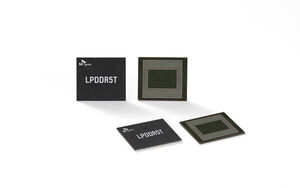
SK hynix Develops World’s Fastest Mobile DRAM LPDDR5T
"SK hynix Inc. (or “the company”, www.skhynix.com) announced today that it has developed the world’s fastest mobile DRAM ‘LPDDR5T (Low Power Double Data Rate 5 Turbo)’ and provided sample products to customers. The new product, LPDDR5T, operates at a data rate of 9.6 gigabits per second (Gbps), 13% faster than the previous generation LPDDR5X1 unveiled in November 2022. To highlight the maximum speed the product features, SK hynix added ‘Turbo’ at the end of the standard name LPDDR5. LPDDR5T, which operates in the ultra-low voltage range of 1.01 to 1.12V set by the JEDEC (Joint Electron Device Engineering Council), is a product that not only features utmost speed but ultra-low power consumption. “The company pushed the technology to new limits in just two months after LPDDR5X, mobile DRAM with 8.5Gbps specification, was introduced to the market in November 2022,” SK hynix said. “We will solidify our leadership in the mobile DRAM market by providing products of various storage capacities that meet customers’ needs.” SK hynix said it provided customers with samples of 16 gigabyte (GB) multi-chip package, which combines multiple LPDDR5T chips into one package." [...]

NASA, DARPA Will Test Nuclear Engine for Future Mars Missions
"NASA and the Defense Advanced Research Projects Agency (DARPA) announced Tuesday a collaboration to demonstrate a nuclear thermal rocket engine in space, an enabling capability for NASA crewed missions to Mars. NASA and DARPA will partner on the Demonstration Rocket for Agile Cislunar Operations, or DRACO, program. The non-reimbursable agreement designed to benefit both agencies, outlines roles, responsibilities, and processes aimed at speeding up development efforts. “NASA will work with our long-term partner, DARPA, to develop and demonstrate advanced nuclear thermal propulsion technology as soon as 2027. With the help of this new technology, astronauts could journey to and from deep space faster than ever – a major capability to prepare for crewed missions to Mars,” said NASA Administrator Bill Nelson. “Congratulations to both NASA and DARPA on this exciting investment, as we ignite the future, together.” Using a nuclear thermal rocket allows for faster transit time, reducing risk for astronauts." [...]

UNH InterOperability Lab and Microchip Technology Partner to Expand 1000BASE-T1 PCS and PHY-C Automotive Compliance Testing
"The University of New Hampshire InterOperability Laboratory (UNH-IOL), an independent provider of broad-based testing and standards conformance services for the networking industry, today announced they have expanded testing for the 1000BASE-T1 PCS and PHY Control market to help further compliance for the automotive industry. By partnering with Microchip Technology, who created a development test platform that is compatible with OPEN Alliance Test Plans for 1000BASE-T1 conformance testing, the automotive industry is even closer to having a complete compliance for chip manufacturers. The enhancements of the testing will allow manufacturers the ability to go to market with greater confidence in their products. Aided by Microchip’s test tool development, complete coverage of conformance testing for physical link training (PHY Control) and coding sublayer (PCS) requirements is now available, which will drive improved interoperability across the industry. “To advance Ethernet in-vehicle networking, multi-vendor, standards-compliant devices are a necessity,” said Charles Forni, Vice President of Microchip’s USB and Networking business unit. “Microchip is pleased to partner with UNH-IOL to enable the test capability to deliver interoperable devices, providing the market with added choice and flexibility for Single Pair Ethernet.” The UNH-IOL has been a key player in the automotive industry supporting the adoption and standardization of in-vehicle Ethernet technologies for many years, contributing to various standards bodies and industry alliances, including IEEE®, Avnu Alliance and OPEN Alliance." [...]

Renesas Introduces New Gate Driver IC for IGBTs and SiC MOSFETs Driving EV Inverters
"The New Gate Driver IC Supports 1200V Power Devices with 3.75kVrms in Isolation Voltage. Renesas Electronics Corporation (TSE: 6723), a premier supplier of advanced semiconductor solutions, today announced a new gate driver IC that is designed to drive high-voltage power devices such as IGBTs (Insulated Gate Bipolar Transistors) and SiC (Silicon Carbide) MOSFETs for electric vehicle (EV) inverters. Gate driver ICs are essential components to EV inverters, providing an interface between the inverter control MCU and the IGBTs and SiC MOSFETs that deliver power to the inverter. They receive control signals from the MCU in the low-voltage domain and transfer these signals to rapidly turn power devices on and off in the high-voltage domain. To accommodate the higher voltages of EV batteries, the RAJ2930004AGM has a built-in 3.75kVrms (kV root mean square) isolator, which is higher than the 2.5kVrms isolator in the previous generation product, and can support power devices with a withstand voltage of up to 1200V. In addition, the new driver IC boasts superior CMTI (Common Mode Transient Immunity) performance at 150 V/ns (nanosecond) or higher, providing reliable communication and increased noise immunity while meeting the high voltages and fast switching speeds required in inverter systems." [...]

NASA’s Fermi Detects First Gamma-Ray Eclipses From ‘Spider’ Star Systems
"Scientists have discovered the first gamma-ray eclipses from a special type of binary star system using data from NASA’s Fermi Gamma-ray Space Telescope. These so-called spider systems each contain a pulsar – the superdense, rapidly rotating remains of a star that exploded in a supernova – that slowly erodes its companion. An international team of scientists scoured over a decade of Fermi observations to find seven spiders that undergo these eclipses, which occur when the low-mass companion star passes in front of the pulsar from our point of view. The data allowed them to calculate how the systems tilt relative to our line of sight and other information. “One of the most important goals for studying spiders is to try to measure the masses of the pulsars,” said Colin Clark, an astrophysicist at the Max Planck Institute for Gravitational Physics in Hannover, Germany, who led the work. “Pulsars are basically balls of the densest matter we can measure." [...]

NASA Validates Revolutionary Propulsion Design for Deep Space Missions
"As NASA takes its first steps toward establishing a long-term presence on the Moon’s surface, a team of propulsion development engineers at NASA have developed and tested NASA’s first full-scale rotating detonation rocket engine, or RDRE, an advanced rocket engine design that could significantly change how future propulsion systems are built. The RDRE differs from a traditional rocket engine by generating thrust using a supersonic combustion phenomenon known as a detonation. This design produces more power while using less fuel than today’s propulsion systems and has the potential to power both human landers and interplanetary vehicles to deep space destinations, such as the Moon and Mars. Engineers at NASA’s Marshall Space Flight Center in Huntsville, Alabama, and primary collaborator IN Space LLC, located in West Lafayette, Indiana, are confirming data from RDRE hot fire tests conducted in 2022 at Marshall’s East Test Area. The engine was fired over a dozen times, totaling nearly 10 minutes in duration. The RDRE achieved its primary test objective by demonstrating that its hardware – made from novel additive manufacturing, or 3D printing, designs and processes – could operate for long durations while withstanding the extreme heat and pressure environments generated by detonations." [...]
Ciência e Tecnologia

Putting clear bounds on uncertainty
"Computer scientists want to know the exact limits in our ability to clean up, and reconstruct, partly blurred images. In science and technology, there has been a long and steady drive toward improving the accuracy of measurements of all kinds, along with parallel efforts to enhance the resolution of images. An accompanying goal is to reduce the uncertainty in the estimates that can be made, and the inferences drawn, from the data (visual or otherwise) that have been collected. Yet uncertainty can never be wholly eliminated. And since we have to live with it, at least to some extent, there is much to be gained by quantifying the uncertainty as precisely as possible. Expressed in other terms, we’d like to know just how uncertain our uncertainty is." [...]

W boson turns 40
"Forty years ago today, physicists at CERN announced to the world that they had discovered the electrically charged carrier of the weak force, one of nature’s four fundamental forces Exactly four decades ago today, on 25 January 1983, physicists at CERN announced to the world that they had observed a new elementary particle – the W boson. Together with its electrically neutral counterpart, the Z boson, which was discovered later in the same year, the electrically charged W boson mediates the weak force, one of nature’s four fundamental forces. Through this force, the W boson enables the nuclear fusion reaction that powers the Sun, without which life as we know it would not be possible. The W boson is also responsible for a form of radioactivity, called radioactive beta decay, that is widely used in medicine. The W boson’s discovery was the result of an idea proposed in 1976 by Carlo Rubbia, Peter McIntyre and David Cline. The trio of physicists suggested converting CERN’s largest accelerator at the time, the Super Proton Synchrotron (SPS), from an accelerator of protons into a machine to collide protons and antiprotons (the protons’ antimatter equivalents) at a high enough energy to produce W and Z bosons." [...]

Quantum computing for drug development and finance applications – Significant Business Finland funding for quantum software research
"Universities at Oulu and Jyväskylä received funding for a 1.2 M€ project for research in applications of quantum computing, programming and software development. The project will create a realistic roadmap for utilization of quantum computing in Finnish enterprises, and educate the first Finnish quantum programmers and software developers. Progress of quantum hardware has recently been rapid, demonstrated by the newly commissioned Finnish Helmi quantum computer. The future quantum practitioners in enterprises and research institutes are well aware of the new disruptive potential of quantum technology in demanding computational tasks. Example use-cases are modeling of large molecules for drug development, and optimization of stock portfolios or complex industrial processes. However, major open questions are that when quantum hardware will be mature enough for specific use-cases, what is quantum programming, when is the right time to invest in quantum software development." [...]
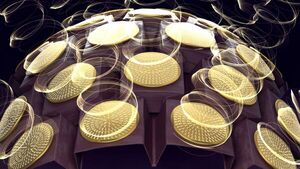
A Princeton lab has designed a new antenna that works ‘like a transformer robot’
"Sophisticated antenna arrays paired with high-frequency wireless chips act like superpowers for modern electronics, boosting everything from sensing to security to data processing. In his lab at Princeton, Kaushik Sengupta is working to expand those powers even further. In recent years, Sengupta’s lab has designed antenna arrays that help engineers make strides toward peering through matter, boosting communications in canyons of skyscrapers, putting a medical lab on a smart phone, and encrypting critical data with electromagnetic waves instead of software. In a new article in Advanced Science, Sengupta’s research team presented a new type of antenna array based on the paper-folding art of origami. The shape-shifting array, designed like a folded paper box called a waterbomb, allows engineers to create a reconfigurable and adaptable radar imaging surface. To build the system, the team installed a new class of broadband metasurface antennas onto standard, flat panels." [...]

No ‘second law of entanglement’ after all
"When two microscopic systems are entangled, their properties are linked to each other irrespective of the physical distance between the two. Manipulating this uniquely quantum phenomenon is what allows for quantum cryptography, communication, and computation. While parallels have been drawn between quantum entanglement and the classical physics of heat, new research demonstrates the limits of this comparison. Entanglement is even richer than we have given it credit for. The power of the second law The second law of thermodynamics is often considered to be one of only a few physical laws that is absolutely and unquestionably true. The law states that the amount of ‘entropy’ – a physical property – of any closed system can never decrease." [...]

Electric car batteries can help drive the clean electricity transition
"As early as 2030, batteries in electric vehicles could fully meet the need for short-term electricity storage around the world. By connecting them to the power grid they can provide their stored energy, improving energy security and enabling renewable technologies in cleaning the grid. Researchers from the Leiden Institute of Environmental Sciences (CML), in collaboration with the US National Renewable Energy Laboratory, published a paper on these opportunities in Nature Communications on January 17. Replacing petrol vehicles with electric ones may be good news for the energy transition, but there are big challenges in avoiding an overloaded grid and meeting demand. With the right approach, electric vehicles can enable the energy transition by smoothing the daily variability in renewable energies like solar and wind. Charging and returning power Electric vehicles can be thought of in terms of transportation, but they are also energy storage devices." [...]

Simple means to a clear view
"The image of an object that is obscured when the light passes through a scattering material can be recovered in real time. A novel method that produces a clear image by using a simple cost-effective random scattering medium in real time could help overcome problems of obscured images. When light passes through a light-scattering material, it is diffused rather than absorbed, which means a clear image of the source object is lost. Scattering media include clouds, which poses problems for Earth-based astronomy, and body tissue, which affects medical imaging. Previous methods for reconstructing scatted light have required some initial knowledge of the object and the ability to control the wavefront of light illuminating it. This has involved complicated optical elements and high vulnerability to motion and mechanical instability." [...]

Recyclable mobile phone batteries a step closer with rust-busting invention
"Mobile phone batteries with a lifetime up to three times longer than today’s technology could be a reality thanks to an innovation led by engineers at RMIT University. Rather than disposing of batteries after two or three years, we could have recyclable batteries that last for up to nine years, by using high-frequency sound waves to remove rust that inhibits battery performance, the team says. Only 10% of used handheld batteries, including for mobile phones, are collected for recycling in Australia, which is low by international standards. The remaining 90% of batteries go to landfill or are disposed of incorrectly, which causes considerable damage to the environment. The high cost of recycling lithium and other materials from batteries is a major barrier to these items being reused, but the team’s innovation could help to address this challenge. The team are working with a nanomaterial called MXene, a class of materials they say promises to be an exciting alternative to lithium for batteries in the future." [...]
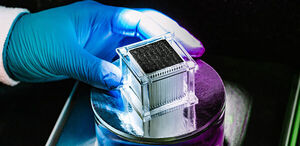
Elevated design keeps solar stills salt-free
"Salt-rejecting microchannels help make seawater drinkable using the power of the sun. A solar distillation device can purify brine from reverse osmosis plants with over 10 percent salinity, as well as water taken directly from the Red Sea. The technology offers double the freshwater production rate of existing salt-rejection solar stills. Inspired by the floating solar still in “The Life of Pi” movie, KAUST professor Qiaoqiang Gan has developed several nanomaterials and thermal isolation processes to enhance the evaporation of brackish water into pure steam. In 2016 he launched a startup, Sunny Clean Water, that produces low-cost inflatable stills capable of generating 10-20 liters of fresh water per day. When it comes to seawater purification, however, Gan admits that even his devices have limits." [...]

Cardboard with a more sustainable coating
"Sterre Bakker defends her thesis at the department of Chemical Engineering and Chemistry on January 27, 2023. On average we open seven packaged items per day, most of them food items. All of this together makes for a mountain of plastic. But more and more often our tomatoes, apples and cookies are packaged in cardboard. To help speed up the transition of plastic to paper, TU/e chemist Sterre Bakker researched what coatings can be used to make cardboard a more suitable food packaging material. About twenty percent of our waste consists of packaging, but packaging food is not all bad." [...]
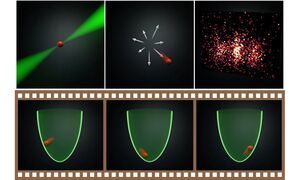
A Quantum Video Reel
"When it comes to creating ever more intriguing quantum systems, a constant need is finding new ways to observe them in a wide range of physical scenarios. JILA Fellow Cindy Regal and JILA and NIST Fellow Ana Maria Rey have teamed up with Oriol Romero-Isart from the University of Innsbruck and IQOQI to show that a trapped particle in the form of an atom readily reveals its full quantum state with quite simple ingredients, opening up opportunities for studies of the quantum state of ever larger particles. In the quantum realm an atom does not behave as point particle, instead it behaves more as a wave. Its properties (e.g., its position and velocity) are described in terms of what is referred to as the wavefunction of the atom. One way to learn about the wavefunction of a particle is to let the atom fly and then capture its location with a camera. And with the right tricks, pictures can be taken of the particle’s quantum state from many vantage points, resulting in what is known as quantum tomography (‘tomo’ being Greek for slice or section, and ‘graphy’ meaning describing or recording)." [...]

Researchers unravel the complex reaction pathways in zero-carbon fuel synthesis
"Researchers have used isotopes of carbon to trace how carbon dioxide emissions could be converted into low-carbon fuels and chemicals. The result could help the chemical industry, which is the third largest subsector in terms of direct CO2 emissions, recycle its own waste using current manufacturing processes. When the eCO2EP: A chemical energy storage technology project started in 2018, the objective was to develop ways of converting carbon dioxide emitted as part of industrial processes into useful compounds, a process known as electrochemical CO2 reduction (eCO2R) While eCO2R is not a new technique, the challenge has always been the inability to control the end products. Now, researchers from the University of Cambridge have outlined how carbon isotopes can be used to trace intermediates during the process, which will allow scientists to create more selective catalysts, control product selectivity, and promote eCO2R as a more promising production method for chemicals and fuels in the low-carbon economy. Their results are reported in the journal Nature Catalysis. The project was led by Professor Alexei Lapkin, from Cambridge’s Centre for Advanced Research and Education in Singapore (CARES Ltd) and Professor Joel Ager, from the Berkeley Education Alliance for Research in Singapore (BEARS Ltd)." [...]

Ultrasonic sensors can safeguard residential gas lines
"UBCO researchers create high-tech system to detect gas leaks. A team of UBC Okanagan researchers is investigating a new method to monitor underground gas pipelines with high-tech sensors that can make it easier to find weaknesses, discrepancies and even a diversion in residential natural gas lines. While there has been considerable research into diagnosis methods for steel pipes such as radiography, ultrasonic testing, visual inspection and ground penetrating radar, Master of Applied Science student Abdullah Zayat says little has been done on the commonly used high-density polyethylene (HDPE) pipe, which carries natural gas to homes. “Early detection of structural degradation is essential to maintaining safety and integrity. And it lowers the risk of catastrophic failure,” he explains. Zayat and his supervisor Dr. Anas Chaaban, Assistant Professor of Electrical Engineering, tested a technique that allows for the inspection of HDPE pipes with ultrasonic sensors—which transmit ultrasound signals through the pipe." [...]

New shield blocks electromagnetic interference while allowing wireless optical signals
"Transparent flexible silver mesh could enable remote sensing and improve operation of shielded devices. Researchers have experimentally demonstrated, for the first time, a mechanically flexible silver mesh that is visibly transparent, allows high-quality infrared wireless optical communication and efficiently shields electromagnetic interference in the X band portion of the microwave radio region. Optical communication channels are important to the operation of many devices and are often used for remote sensing and detection. Electronic devices are now found throughout our homes, on factory floors and in medical facilities. Electromagnetic interference shielding is often used to prevent electromagnetic radiation from these devices from interfering with each other and affecting device performance. Electromagnetic shielding, which is also used in the military to keep equipment and vehicles hidden from the enemy, can also block the optical communication channels needed for remote sensing, detection or operation of the devices." [...]
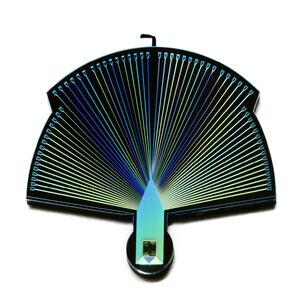
New detector could enable high-speed quantum communication
"Researchers use a superconducting nanowire design for fast and precise photon counting Researchers have developed a new detector that can precisely measure single photons at very high rates. The new device could help make high-speed quantum communication practical. Quantum communication uses light at the single photon level to send encoded quantum information such as encryption keys in quantum key distribution. Because of the laws of physics, data transmitted in this way is guaranteed to remain secure. Sending information at faster speeds requires a single photon detector that can not only detect photons quickly but also precisely measure their arrival times. In Optica, Optica Publishing Group’s journal for high-impact research, researchers led by Matthew D. Shaw at NASA’s Jet Propulsion Laboratory describe and demonstrate their new detector for measuring the arrival times of photons, which they call PEACOQ (performance-enhanced array for counting optical quanta) detector." [...]
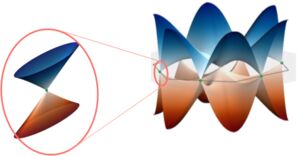
Scientists observe “quasiparticles” in classical systems for the first time
"Quasiparticles – long-lived particle-like excitations – are a cornerstone of quantum physics, with famous examples such as Cooper pairs in superconductivity and, recently, Dirac quasiparticles in graphene. Now, IBS CSLM researchers have discovered quasiparticles in a classical system at room temperature: a two-dimensional crystal of particles driven by viscous flow in a microfluidic channel. Coupled by hydrodynamic forces, the particles form stable pairs – a first example of classical quasiparticles, revealing deep links between quantum and classical dissipative systems. Starting with the emergence of quantum mechanics, the world of physics has been divided between classical and quantum physics. Classical physics deals with the motions of objects we typically see every day in the macroscopic world, while quantum physics explains the exotic behaviors of elementary particles in the microscopic world. Many solids or liquids are composed of particles interacting with one another at close distances, which sometimes results in the rise of “quasiparticles.” Quasiparticles are long-lived excitations that behave effectively as weakly interacting particles." [...]
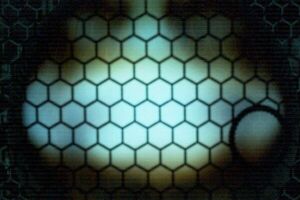
How a 3 cm glass sphere could help scientists understand space weather
"UCLA study overcomes the effects of Earth’s gravity, replicating conditions on other planets, stars. Solar flares and other types of space weather can wreak havoc with spaceflight and with telecommunications and other types of satellites orbiting the Earth. But, to date, scientists’ ability to research ways to overcome that challenge has been severely limited. That’s because experiments they conduct in laboratories here on Earth are affected by gravity in ways that are so different from conditions in space. But a new study by UCLA physicists could, at last, help conquer that issue — which could be a big step toward safeguarding humans (and equipment) during space expeditions, and to ensuring the proper functioning of satellites. The paper is published in Physical Review Letters." [...]

Electronic Bridge Allows Rapid Energy Sharing Between Semiconductors
"As semiconductor devices become ever smaller, researchers are exploring two-dimensional (2D) materials for potential applications in transistors and optoelectronics. Controlling the flow of electricity and heat through these materials is key to their functionality, but first we need to understand the details of those behaviors at atomic scales. Now, researchers have discovered that electrons play a surprising role in how energy is transferred between layers of 2D semiconductor materials tungsten diselenide (WSe2) and tungsten disulfide (WS2). Although the layers aren’t tightly bonded to one another, electrons provide a bridge between them that facilitates rapid heat transfer, the researchers found. “Our work shows that we need to go beyond the analogy of Lego blocks to understand stacks of disparate 2D materials, even though the layers aren’t strongly bonded to one another,” said Archana Raja, a scientist at the Department of Energy’s Lawrence Berkeley National Laboratory (Berkeley Lab), who led the study. “The seemingly distinct layers, in fact, communicate through shared electronic pathways, allowing us to access and eventually design properties that are greater than the sum of the parts.” The study appeared recently in Nature Nanotechnology and combines insights from ultrafast, atomic-scale temperature measurements and extensive theoretical calculations." [...]

Light-based tech could inspire Moon navigation and next-gen farming
"Super-thin chips made from lithium niobate are set to overtake silicon chips in light-based technologies, according to world-leading scientists in the field, with potential applications ranging from remote ripening-fruit detection on Earth to navigation on the Moon. They say the artificial crystal offers the platform of choice for these technologies due to its superior performance and recent advances in manufacturing capabilities. RMIT University's Distinguished Professor Arnan Mitchell and University of Adelaide's Dr Andy Boes led this team of global experts to review lithium niobate's capabilities and potential applications in the journal Science. The international team, including scientists from Peking University in China and Harvard University in the United States, is working with industry to make navigation systems that are planned to help rovers drive on the Moon later this decade. As it is impossible to use global positioning system (GPS) technology on the Moon, navigation systems in lunar rovers will need to use an alternative system, which is where the team's innovation comes in. By detecting tiny changes in laser light, the lithium-niobate chip can be used to measure movement without needing external signals, according to Mitchell." [...]
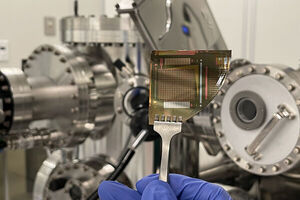
Two technical breakthroughs make high-quality 2D materials possible
"Researchers have been looking to replace silicon in electronics with materials that provide a higher performance and lower power consumption while also having scalability. An international team is addressing that need by developing a promising process to develop high-quality 2D materials that could power next-generation electronics. Sang-Hoon Bae, an assistant professor of mechanical engineering and materials science at the McKelvey School of Engineering at Washington University in St. Louis, is one of three researchers leading the multi-institutional work published Jan. 18 in Nature, together with his doctoral student Justin S. Kim and postdoctoral research associate Yuan Meng. The work, which includes two technical breakthroughs, is the first to report that their method to grow semiconductor materials, known as transition metal dichalcogenides (TMD), would make devices faster and use less power. The team, co-led by Jeehwan Kim, an associate professor of mechanical engineering and of materials science and engineering at the Massachusetts Institute of Technology, and Jin-Hong Park, a professor of information and communication engineering and of electronic and electrical engineering at Sungkyunkwan University, had to overcome three extremely difficult challenges to create the new materials: securing single crystallinity at wafer-scale; preventing irregular thickness during growth at wafer-scale; and vertical heterostructures at wafer-scale. Bae said 3D materials go through a process of roughening and smoothing to become an even-surfaced material." [...]

Mimicking an Enigmatic Property of Circadian Rhythms through an Artificial Chemical Clock
"Circadian rhythms are natural, internal oscillations that synchronize an organism's behaviors and physiological processes with their environment. These rhythms normally have a period of 24 hours and are regulated by internal chemical clocks that respond to cues from outside the body, such as light. Although well studied in animals, plants, and bacteria, circadian rhythms all share an enigmatic property -- the oscillation period is not significantly affected by temperature, even though the rate of most biochemical reactions changes exponentially with temperature. This clearly indicates that some sort of temperature-compensation mechanism is at play. Interestingly, some scientists have managed to replicate such temperature-invariant qualities in certain oscillating chemical reactions. However, these reactions are often troublesome and require extremely precise adjustments on the reacting chemicals." [...]

Electrons in the Fast Lane
"By using ultrafast laser flashes, scientists at the University of Rostock in collaboration with researchers of the Max Planck Institute for Solid State Research in Stuttgart have generated and measured the shortest electron pulse to date. The electron pulse was created by using lasers to remove electrons from a tiny metal tip and lasted only 53 attoseconds, that is, 53 billionths of a billionth of a second. This study is setting a new speed record in man-made control of electric currents in solid materials. The research opens new avenues for advancing the performance of electronics and information technologies, as well as for developing new scientific methodologies for visualizing phenomena in the microcosm at ultimate speeds. Ever wondered what makes your computer and your other electronic gadgets slow or fast in their performance? It is the time it takes electrons, some of the tiniest particles of our microcosm, to stream out from minute leads inside the transistors of electronic microchips and to form pulses." [...]

Graphene researchers discover long-term memory in 2D nanofluidic channels
"Published in Science, a collaboration between teams from the National Graphene Institute (NGI) at The University of Manchester, and the École Normale Supérieure (ENS), Paris, demonstrated the Hebbian learning in artificial nanochannels, where the channels showed short and long term memory. Hebbian learning is a technical term introduced in 1949 by Donald Hebb, describing the process of learning by repetitively doing an action. Hebbian learning is a well-known learning mechanism, it is the process when we ‘get used’ to doing an action. Similar to what occurs in neural networks, the researchers were able to show the existence of memory in two-dimensional channels which are similar to atomic-scale tunnels with heights varying from several nanometers down to angstroms (10-10 m). This was done using simple salts (including table salt) dissolved in water flowing through nanochannels and by the application of voltage (< 1 V) scans/pulses. The study spotlights the importance of the recent development of ultrathin nanochannels." [...]
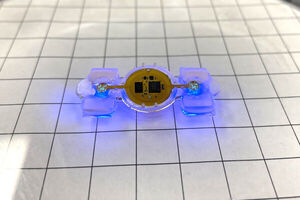
Microelectronics give researchers a remote control for biological robots
"First, they walked. Then, they saw the light. Now, miniature biological robots have gained a new trick: remote control. The hybrid “eBiobots” are the first to combine soft materials, living muscle and microelectronics, said researchers at the University of Illinois Urbana-Champaign, Northwestern University and collaborating institutions. They described their centimeter-scale biological machines in the journal Science Robotics. “Integrating microelectronics allows the merger of the biological world and the electronics world, both with many advantages of their own, to now produce these electronic biobots and machines that could be useful for many medical, sensing and environmental applications in the future,” said study co-leader Rashid Bashir, an Illinois professor of bioengineering and dean of the Grainger College of Engineering." [...]

Scientists Unveil Least Costly Carbon Capture System to Date
"PNNL scientists carve a path to profit from carbon capture through carbon upcycling, unlock crucial step in decarbonization and advancing toward net zero emissions The need for technology that can capture, remove and repurpose carbon dioxide grows stronger with every CO2 molecule that reaches Earth’s atmosphere. To meet that need, scientists at the Department of Energy’s Pacific Northwest National Laboratory have cleared a new milestone in their efforts to make carbon capture more affordable and widespread. They have created a new system that efficiently captures CO2—the least costly to date—and converts it into one of the world’s most widely used chemicals: methanol. Snaring CO2 before it floats into the atmosphere is a key component in slowing global warming. Creating incentives for the largest emitters to adopt carbon capture technology, however, is an important precursor. The high cost of commercial capture technology is a longstanding barrier to its widespread use." [...]
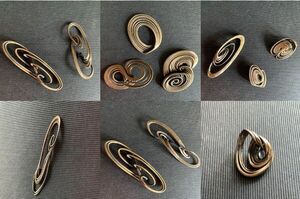
A Butterfly Flaps Its Wings and Scientists Make Jewelry
"3D printing creates unique jewelry using the principles of chaos The further out in time, the more unreliable a weather forecast. That’s because small variations in initial weather conditions can completely change the entire system, making it unpredictable. Put another way, in the “butterfly effect,” an insect can flap its wings and create a microscopic change in initial conditions that leads to a hurricane halfway around the world. This chaos is seen everywhere, from weather to labor markets to brain dynamics. And now, in the journal Chaos, by AIP Publishing, researchers from the University of Calabria explored how to turn the twisting, fractal structures behind the science into jewelry with 3D printing. The jewelry shapes are based on the Chua circuit, a simple electronic system that was the first physical, mathematical, and experimental proof of chaos." [...]
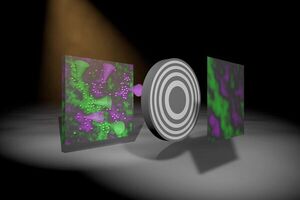
Colour images from the shadow of a sample
"Researchers at Göttingen University develop new method for X-ray colour imaging A research team at the University of Göttingen has developed a new method to produce X-ray images in colour. In the past, the only way to determine the chemical composition of a sample and the position of its components using X-ray fluorescence analysis was to focus the X-rays and scan the whole sample. This is time-consuming and expensive. Scientists have now developed an approach that allows an image of a large area to be produced from a single exposure, without the need for focusing and scanning. The method was published in the journal Optica. In contrast to visible light, there are no comparably powerful lenses for “invisible” radiation, such as X-ray, neutron or gamma radiation." [...]
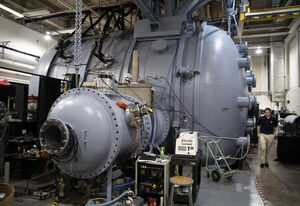
Plasma thrusters used on satellites could be much more powerful
"It was believed that running more propellant through a Hall thruster would wreck its efficiency, but new experiments suggest they might power a crewed mission to Mars. It was believed that Hall thrusters, an efficient kind of electric propulsion widely used in orbit, need to be large to produce a lot of thrust. Now, a new study from the University of Michigan suggests that smaller Hall thrusters can generate much more thrust—potentially making them candidates for interplanetary missions. “People had previously thought that you could only push a certain amount of current through a thruster area, which in turn translates directly into how much force or thrust you can generate per unit area,” said Benjamin Jorns, U-M associate professor of aerospace engineering who led the new Hall thruster study to be presented at the AIAA SciTech Forum in National Harbor, Maryland, today. His team challenged this limit by running a 9 kilowatt Hall thruster up to 45 kilowatts, maintaining roughly 80% of its nominal efficiency. This increased the amount of force generated per unit area by almost a factor of 10." [...]
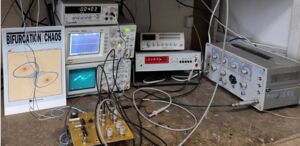
St Petersburg University mathematicians prove the existence of hidden attractors in an electrical circuit
"Scientists from St Petersburg University and the Kotelnikov Institute of Radioengineering and Electronics of the Russian Academy of Sciences (IRE RAS), together with Professor Leon Chua from the University of California, Berkeley, have demonstrated experimentally the existence of hidden attractors — points in the basins of attraction in a simple electrical circuit. An attractor in a dynamical system is a set of states toward which the system tends to evolve over time. One of the examples of systems with trivial attractors is a roly-poly toy. The attractor here will be an upright position, the so-called state of rest. Another example is a swinging pendulum, for which the attractor will be the pendulum’s equilibrium position when it hangs vertically. However, there are also attractors of another type: chaotic attractors." [...]
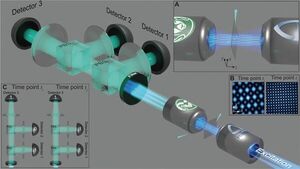
Researchers combine classical and quantum optics for super-resolution imaging
"The ability to see invisible structures in our bodies, like the inner workings of cells, or the aggregation of proteins, depends on the quality of one’s microscope. Ever since the first optical microscopes were invented in the 17th century, scientists have pushed for new ways to see more things more clearly, at smaller scales and deeper depths. Randy Bartels, professor in the Department of Electrical Engineering at Colorado State University, is one of those scientists. He and a team of researchers at CSU and Colorado School of Mines are on a quest to invent some of the world’s most powerful light microscopes – ones that can resolve large swaths of biological material in unimaginable detail. The name of the game is super–resolution microscopy, which is any optical imaging technique that can resolve things smaller than half the wavelength of light. The discipline was the subject of the 2014 Nobel Prize in Chemistry, and Bartels and others are in a race to keep circumventing that diffraction limit to illuminate biologically important structures inside the body." [...]
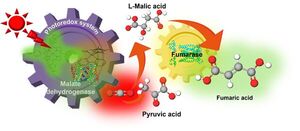
Artificial photosynthesis uses sunlight to make biodegradable plastic
"In recent years, environmental problems caused by global warming have become more apparent due to greenhouse gases such as CO2. In natural photosynthesis, CO2 is not reduced directly, but is bound to organic compounds which are converted to glucose or starch. Mimicking this, artificial photosynthesis could reduce CO2 by combining it into organic compounds to be used as raw materials, which can be converted into durable forms such as plastic. A research team led by Professor Yutaka Amao from the Research Center for Artificial Photosynthesis and graduate student Mika Takeuchi, from the Osaka Metropolitan University Graduate School of Science, have succeeded in synthesizing fumaric acid from CO2, a raw material for plastics, powered -- for the first time -- by sunlight. Their findings were published in Sustainable Energy & Fuels. Fumaric acid is typically synthesized from petroleum, to be used as a raw material for making biodegradable plastics such as polybutylene succinate, but this discovery shows that fumaric acid can be synthesized from CO2 and biomass-derived compounds using renewable solar energy." [...]
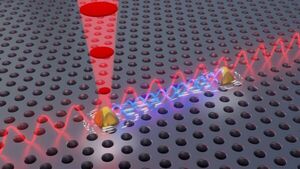
Danish quantum physicists make nanoscopic advance of colossal significance
"QUANTUM PHYSICS In a new breakthrough, researchers at the University of Copenhagen, in collaboration with Ruhr University Bochum, have solved a problem that has caused quantum researchers headaches for years. The researchers can now control two quantum light sources rather than one. Trivial as it may seem to those uninitiated in quantum, this colossal breakthrough allows researchers to create a phenomenon known as quantum mechanical entanglement. This in turn, opens new doors for companies and others to exploit the technology commercially. Going from one to two is a minor feat in most contexts. But in the world of quantum physics, doing so is crucial." [...]
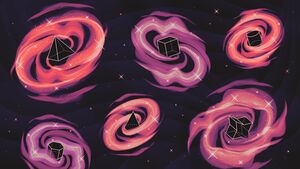
Mathematicians Find an Infinity of Possible Black Hole Shapes
"The cosmos seems to have a preference for things that are round. Planets and stars tend to be spheres because gravity pulls clouds of gas and dust toward the center of mass. The same holds for black holes — or, to be more precise, the event horizons of black holes — which must, according to theory, be spherically shaped in a universe with three dimensions of space and one of time. But do the same restrictions apply if our universe has higher dimensions, as is sometimes postulated — dimensions we cannot see but whose effects are still palpable? In those settings, are other black hole shapes possible? The answer to the latter question, mathematics tells us, is yes." [...]
Documentação
A documentação é parte essencial do processo de aprendizagem e a Internet além de artigos interessantes de explorar também tem alguma documentação em formato PDF interessante de ler. Todos os links aqui apresentados são para conteúdo disponibilizado livremente pelo editor do livro.
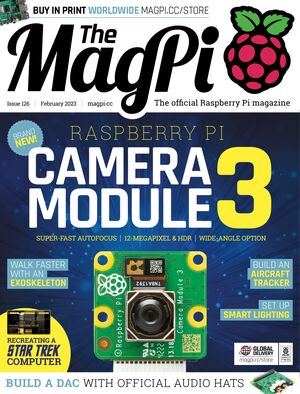
The MagPi 126
"- Camera Module 3. Details and technical specifications. Plus! In-depth engineering interview, project ideas and resources - Raspberry Pi Smart Lights. Light up your life with NeoPixel strips, automated lights and PiHue coding. - Create a Star Trek computer." [...]
Projetos Maker
Diversos Projetos interessantes.

Sandwich Dot IO
"Hey everyone, what's up? So here's something super interesting and cool: SANDWICH DOT IO. It's a Raspberry Pi system with onboard power, a dedicated cooling layer, and even RGB LEDs for aesthetics. This setup was created to address a problem I encountered while working on a Raspberry Pi-based project: I wanted to create a small game emulator using the RPI 3B+, but the problem was the power supply. A 5V adaptor was used for powering the Raspberry Pi. A fan was also required to keep the Pi cool, but I had to add another 5V supply for it as we cannot plug it directly into the 5V of the Raspberry Pi." [...]

PCB Binary Watch
"I love PCB. I love Binary. A few years ago when I was browsing the Instructables one project attracted me very much. The project was a PCB watch named The Nerd Watch. When I saw that I fall in love with the watch. I tried to make one but I didn't have all the tools to make the watch." [...]
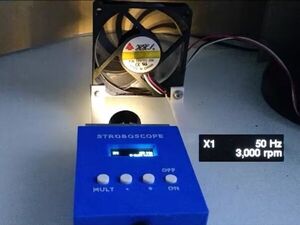
Stroboscope
"A simple tool to measure speeds of rotating objects Stroboscope is a flashing light that can provide light pulses at a variable rate. When a rotating object is observed in a powerful beam of pulsed light with the frequency of that pulsed light matching the rotations per second of the rotating object, the rotating object appears stationary. This allows the speed of any rotating object to be calculated by varying the pulse rate until the rotating object appears stationary. Once this state is achieved, revolutions per minute (rpm) of the rotating object can be calculated from the frequency of the pulsed light. If the object appears to be stationary when the pulsed light is at a frequency of 50Hz or 50 times a second, the object is rotating at 3,000 rpm (50 x 60). " [...]

Reverse-engineering the conditional jump circuitry in the 8086 processor
"Intel introduced the 8086 microprocessor in 1978 and it had a huge influence on computing. I'm reverse-engineering the 8086 by examining the circuitry on its silicon die and in this blog post I take a look at how conditional jumps are implemented. Conditional jumps are an important part of any instruction set, changing the flow of execution based on a condition. Although this instruction may seem simple, it involves many parts of the CPU: the 8086 uses microcode along with special-purpose condition logic. The die photo below shows the 8086 microprocessor under a microscope. The metal layer on top of the chip is visible, with the silicon and polysilicon mostly hidden underneath." [...]

HexLight
"Made a Custom HexLight consist of WS2812 2020 package LEDs and Attiny85 all jam packed in a 3D Printed body. HEXLIGHT is a small, hexagon-shaped RGB light that is created using custom PCBs and a 3D-printed body. An Attiny85 MCU controls 48 WS2812 2020 Package Mini Addresable LEDs in this system. The idea behind this project was to create a modern RGB light that I could add to my display for aesthetic purposes. It adds to the overall appearance of the desk. Inside the PLA-based 3D-printed body, six PCBs are housed and joined in the form of a hexagon." [...]
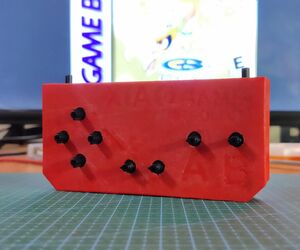
Arduino Game Controller for NES and GBA
"Made a Simple Game Controller with Seeed's XIAO M0 DEV Board and 3D Printed body. So here's a FUN little project that involves retro games: To play classic games like Super Mario, Metroid, The Legend of Zelda, and many others, the Arduino Game Controller Project was constructed. The internals of this NES-GBA Controller are buttons soldered on a perf board connected to an XIAO M0 Dev Board, which powers the entire controller. The controller's body is entirely 3D printed. The XIAO M0 SAMD21 Dev Board from Seeed is compatible with the GamePad Library since it supports HID, which is crucial for this project. This project cannot be built using well-known boards like the Arduino Uno or Nano, as they do not have HID support." [...]
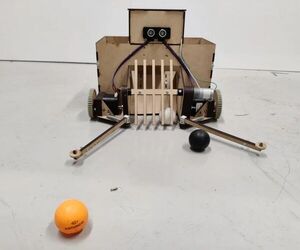
Ping Pong Ball Collector Robot
"Practicing sports is fun and good for your physical and mental health. However, there are drawbacks while practicing a sport, take for example table tennis also known as ping pong. It is one of the most popular sports in China and it is widely known. Ping pong is a fast paced sport which rewards good technique and fast reaction times. During a training session of ping pong the players engage in a dynamic match, hitting and smashing balls everywhere (preferebly on the table ;)) ). As a consequence, at the end of the training set, the floor is completely covered with small ping pong balls... and it is time to pick them up." [...]

Recreating classic games with a bare MCU
"Some time ago, I hatched a plan to introduce my kids to a handful of classic computer games. This wasn’t a matter of misplaced nostalgia: I’m not overly sentimental and I’d rather play Horizon Zero Dawn than Pong. Instead, I wanted to show how simple the design of a computer game can be — perhaps to encourage them to tinker on their own. With their assistance, I ended up building three handheld games. It proved to be an enjoyable pursuit and a source of more joy than I anticipated — so I wanted to share some practical notes, technical details, and gameplay videos for posterity. Game #1: TurboSnake 2000 and 25000 In this classic genre, the player controls a constantly-moving snake." [...]
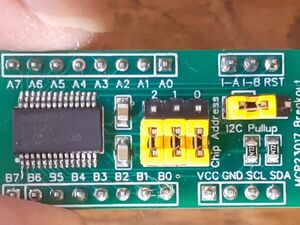
Redesigned MCP23017 Breakout
"A completely redesigned MCP23017 IO expander breakout, easy to use and breadboard friendly. New style MCP23017 Breakout – Top view There will not be a lot of obvious differences at first, but if we look closely, here are the changes:– In the old version, due to the size of the SOIC28 footprint, I had to place the bypass capacitors, as well as I2C pullup resistors on the bottom layer of the PCB. - The new design, using the more readily available ( at least where I live) SSOP28 footprint, leaves enough space for these components on the top layer, thus resulting in a mostly single-layer layout, with only a few tracks on the bottom layer. - I2C pull-up resistors can now be controlled by a jumper, enabling or disabling them completely… This helps when adding a few devices to the I2C bus, and rather having the pull-up’s close to the MCU ( as is generally recommended anyway ) - Other cosmetic changes involve the separation of the data ports (A and B) from the interrupts, reset, Vcc and ground pins. On initial testing of this on a breadboard, it makes using the device a bit easier, and access to the io pins faster. ( In my biased opinion anyway ) Pinouts and connections I have tried to make all the connections easy to find and use, with the IO ports ( A and B) on opposite sides of the breakout, Numbered A7 to A0 on the top, and B7 to B0 on the bottom." [...]

CWvox, A voice keyer for Morse C
"Morse Code, often referred to by Ham Radio folks simply as CW, is usually sent using a hand operated switch called a 'Key'. You've seen these somewhere, the old telegraph key. Another device called a 'Keyer' can automatically generate the long and short tones, the dashes and dots Morse is comprised of. A keyer will use a set of paddles, two parts that sit between your index finger and thumb. Press one and a series of long tones is generated, press the other and a series of short tones is generated. These two methods are by far the most common way of operating a transmitter to send Morse over the air." [...]

3D Printed Arduino Based Analog Digital Clock - Reincarnated.
"This is a Digital Clock design that was built from 24 custom 3D printed analog clocks. It shows the digital time. Between time displays, it shows moving artwork. It is composed of 3D printed parts, 25 Arduino nanos and 48 stepper motors. Each clock face uses a custom Eagle designed PCB which can be ordered easily. The total price I paid to build this was about $500." [...]

8Ch PMOS breakout Board PCB
"Easy to use, 8 Ch PMOS breakout that is breadboard compatible. While prototyping our projects, we Makers often need to interface devices with a higher current draw, like motors, or RGB lights, to our microcontrollers. These typically are unsuitable for connecting directly to an Arduino, ESP32 or Raspberry Pi’s GPIO pins. This is usually the time when we start grabbing transistors or MOSFETs.While I normally keep a few leaded transistors and MOSFETs in the lab, These are not always convenient to use, as they may be in big packages or have the wrong specifications for the task that we are trying to perform. SMD versions are more common in my lab, but they come with the problem of being small, and also completely unfriendly to the breadboard environment. I have thus been playing with an idea to make a series of dedicated breakout boards for just this purpose." [...]
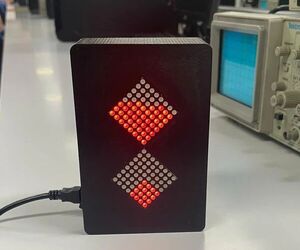
Arduino Hourglass
"Mathias Ferreira and David Flores, students of 'Creative Electronics', a Beng Electronics Engineering module at theUniversity of Mlaga, School of Telecommunications. What about to apply Arduino and electronics knowledge over an ancient invention as the hourglass is? Well, that is what we did for our Creative Electronics final project. We combined both ideas in order to improve and create a more attractive device. We give thanks to Edison Science Corner because they gave us a wide range of ideas about the Arduino Hourglass and we added some other improvements. The functioning consists in a led hourglass with gravity sensitivity, where we added the way to set up the time in minutes and seconds that the hourglass is working." [...]

DIY Smart Home Upgrade: Turn Your IKEA Curtains Into Smart Blinds
"With being active in home automation for the last 5 years, Ive by now (like most of you) automated all my lights and put temperature and humidity sensors on more places than strictly necessary. So, it only logical next step in my home automation journey is.. automating my curtains! I quickly figured out that the off-the-shelf solutions are eitherexpensive,need chargingor simply dont exist for curtain rods. So the only logical step is to go the DIY route! Supplies - IKEA Bekräfta curtain rod - IKEA Betydlig wall bracket - IKEA Syrlig curtain rings (to reduce the friction of the curtain) - Curtains of your liking - 12v, 5A power supply (to power the ESP and motors) - LM2596S Step down converter (to power the ESP) - 2x Nema 17 ~3–4 N. cm stepper motors (I tried with one, but that wasn’t powerful enough to perform at the speed I’d like) - 1x ESP8266 such as the Wemos D1 Mini or NodeMCU - 2x A4988 Stepper drivers - 2x 100mF & 2x 10mF capacitator - 2x GT2 16-tooth wheel bore (to use with the timing belt. I tried with a cable as well, but that would have insufficient grip) - 5 meters timing belt - 8x m3 bolts (to connect the stepper motor to the 3D print) - 4x m5 bolts (to connect the stepper motor mount to the wall brackets) - Cables to connect stepper motors (I used old network cables) - Dupont cables 3D printer for: - 1 timing belt clip, - 2 stepper motor mounts - 1 box for electronic - 1 lid" [...]

Responsive Soundbars for Speakers
"Hi everyone, On this Instructables, I will explain how I manage to add responsive soundbars to my Z200 Logitech speaker. I think this project will work similarly on other types of speakers. The main idea is to fix the sound bars in my direction, but also to power them permanently. This project is non-destructive for the speakers, all can be disassembled invisibly. The soundbars are held to the speaker using magnets, so they can be easily removed for use elsewhere Check the end result on my desk at the end of this Instructables. To make the custom soundbars for your speaker you need : - 1x superglue - 1x flexible double-sided tape (at least 20mm wide) - 2x soundbar (with the USB type C cable) - In this Instructables, I got the rechargeable sound bar, but you can take the plug-in version - 6x D6xH2 magnets - 1x Z200 Logitech speakers - 7x printing parts Required tools : - A soldering iron - A 3D printer - A glue gun - Some screwdriver - A cutter - A pair of pliers - A wire stripper Optional tools : - A Dremel - A multimeter - A 3r hand - A vice" [...]

Reverse-engineering the Intel 8086 processor's HALT circuits
"The 8086 processor was introduced in 1978 and has greatly influenced modern computing through the x86 architecture. One unusual instruction in this processor is HLT, which stops the processor and puts it in a halt state. In this blog post, I explain in detail how the halt circuitry is implemented and how it interacts with the 8086's architecture. The die photo below shows the 8086 microprocessor under a microscope. The metal layer on top of the chip is visible, with the silicon and polysilicon mostly hidden underneath. Around the edges of the die, bond wires connect pads to the chip's 40 external pins." [...]
Secção Videos
Videos interessantes.
That's all Folks!



